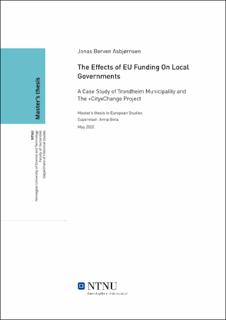| dc.description.abstract | The European Union’s funding programmes for research and innovation are becoming
increasingly ambitious and consequential. The current programme is called Horizon 2020,
and over a seven-year period, about 80 billion euros is distributed to those institutions
that manage to succeed in the increasingly fierce competition against other applicants. In
recent years, smart cities have become a way for local governments to improve their
communities while pushing toward climate goals and stimulating economic growth. This
is reflected in Horizon 2020 with the introduction of Lighthouse Cities. In 2018,
Trondheim became such a city, and the municipality of Trondheim’s largest ever EU
project became reality. Suddenly, a municipality that had very little experience with
working on EU projects became a living laboratory for a cutting-edge smart city project
that has garnered international attention and millions of euro in EU funding.
This thesis aims to discover how +CityxChange is affecting the municipality of Trondheim
both in terms of its structure and operational conventions and in terms of its policy focus
and output. Through using the concepts of expertisation, projectification, triple helix,
smart city drivers and europeanisation, the incentives for partaking in the project as well
as recent and current developments in the municipality are examined. In order to do this,
central participants in the project across all sectors have been interviewed, forming the
basis of the data used in this qualitative case study.
The findings in this thesis highlight that the smart city project has brought with it and is
symptomatic of considerable changes to the municipality of Trondheim. This is true both
in terms of operational structure and policy output – the policy focus seems to remain
relatively unchanged. Trondheim municipality is becoming an institution that is garnering
more EU expertise and an orientation toward more project-oriented working methods.
Furthermore, the partnership of municipality-university-industry has become significantly
strengthened throughout the work with +CityxChange. Finally, the results show that
through becoming a Lighthouse City, the municipality is able to work towards reaching
several of their strategic goals in an innovative manner and that this was one of the main
incentives for partaking in the ambitious project.
The symbiosis between the partners in the project consortium is something that receives
special attention in this thesis, and this has affected the results from the analysis. The
coordinating role of NTNU seems to function as a sort of buffer between the municipality
and the effects of some of the concepts. The effects of expertisation and projectification
are lower than initially assumed due to the municipality’s unique role in the project. This
is an interaction that is not adequately accounted for in surrounding literature, and that
should be particularly noted. | |
